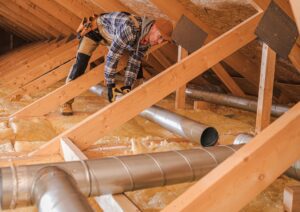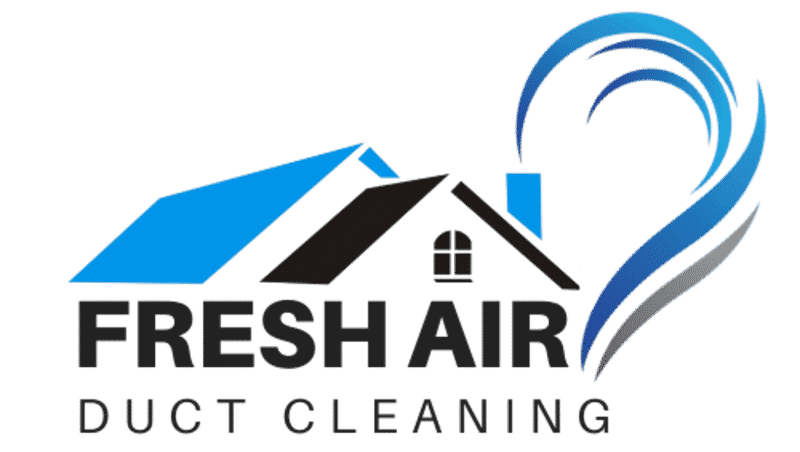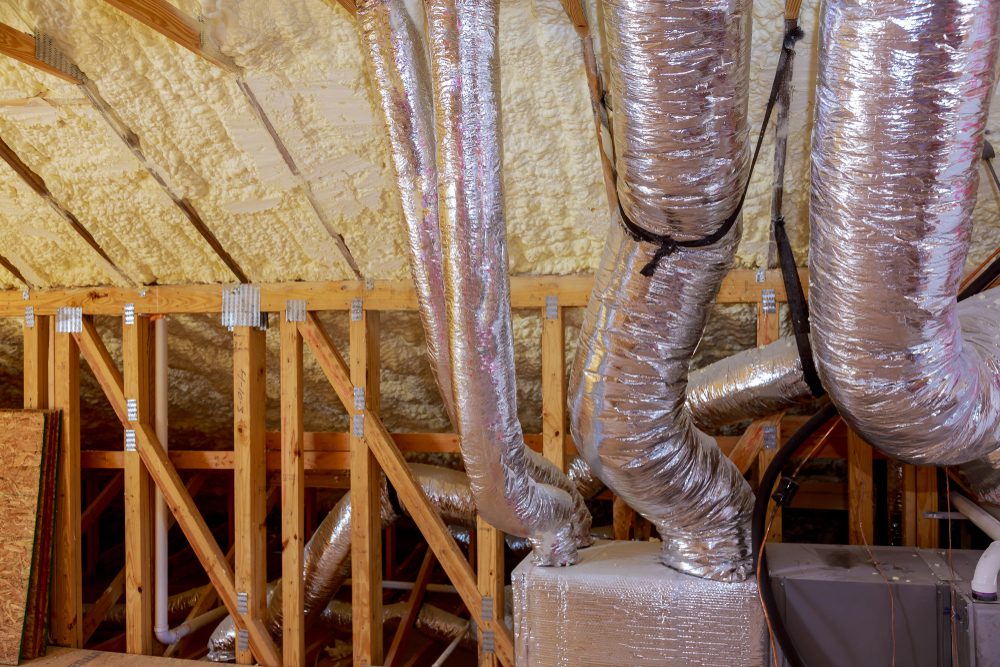Why Duct Insulation Matters: Understanding the Impact on Energy Efficiency
Duct insulation may not be the most glamorous aspect of household maintenance, but it plays a crucial role in our energy efficiency. When heating or cooling air is forced through our ductwork without proper insulation, a significant amount of energy can be lost along the way. As a result, our heating and cooling systems have to work harder and longer to achieve the desired temperature in our living spaces. By investing in duct insulation, we can minimize this energy loss and ultimately reduce our utility bills.
One key factor to consider when it comes to duct insulation is the choice of insulation material. There are various options available, each with its own pros and cons. Fiberglass insulation, for example, is a popular choice due to its affordability and ability to effectively trap heat or cool air. Another option is foam board insulation, which offers excellent thermal resistance but may be more expensive. Ultimately, the choice of insulation material will depend on factors such as budget, desired energy efficiency, and any specific concerns regarding air quality or allergens.
The Basics of Ductwork: How It Works and Common Issues
Ductwork is an essential component of any heating, ventilation, and air conditioning (HVAC) system. It is responsible for transporting conditioned air from the HVAC unit to different parts of the building. Understanding how ductwork works is crucial in identifying and addressing common issues that can arise.
At its core, ductwork functions as a network of pathways that distribute air throughout a building. The HVAC unit pushes air into the ducts, and it travels through the system to reach individual rooms or areas. The design of the ductwork is critical in ensuring proper airflow and temperature control. Issues such as leaks, obstructions, or improper sizing can significantly impact the system’s performance and efficiency.
Common issues with ductwork often revolve around airflow problems. Leaks or gaps in the ducts can lead to air escaping instead of reaching its intended destination. This leakage not only wastes energy but also affects the system’s ability to achieve consistent temperatures throughout the building. Another common issue is poor insulation, which can result in energy loss as well as condensation and moisture problems. By understanding these common issues, homeowners and HVAC professionals can take appropriate steps to address them and ensure optimal performance and efficiency in their ductwork systems.
Identifying Heat Loss and Heat Gain in Ducts: A Step-by-Step Guide
When it comes to identifying heat loss and heat gain in ducts, it’s important to take a step-by-step approach to ensure accuracy and efficiency. The first step is to visually inspect the ductwork for any obvious signs of damage or air leaks. Look for cracks, gaps, or loose connections that may be allowing air to escape or enter the ducts. Next, perform a manual touch test along the length of the ductwork. Feel for any areas that are significantly warmer or cooler than the surrounding air. These temperature variations can indicate areas of heat loss or gain.
To further determine the extent of heat loss or gain, consider using an infrared camera or thermal imaging device. These tools can provide a visual representation of temperature differences along the ducts, allowing you to pinpoint specific areas that may be problematic. Remember, the goal is to identify and address any areas of heat loss or gain to improve the overall energy efficiency of your ductwork. When you follow these step-by-step guidelines, you will be able to identify and address any issues effectively, ensuring optimal performance and cost savings.
Choosing the Right Insulation Material for Your Ductwork
There are several key factors to consider when choosing the right insulation material for your ductwork. One of the most important considerations is the R-value of the insulation, which measures its thermal resistance. A higher R-value means better insulation and greater energy efficiency.
That said, it’s also important to consider the cost of the insulation and the specific needs of your ductwork. For example, if your ducts are located in an area with high humidity, you may need to choose insulation that is resistant to moisture or mold. Similarly, if your ducts are exposed to extreme temperatures, you may need insulation that can withstand those conditions. By carefully considering these factors and weighing the tradeoffs involved, you can select an insulation material that meets both your energy efficiency goals and the unique needs of your ductwork.
Another important factor to consider when choosing insulation material is the ease of installation. Some insulation materials require professional installation, while others are more DIY-friendly. If you have the time and skills, you may be able to save money by installing the insulation yourself.
If you’re not comfortable with DIY projects or if your ductwork is complex, it’s best to hire a professional to ensure proper installation. You should consider the long-term maintenance requirements of the insulation material. Some materials may require regular cleaning or replacement, while others are more durable and low-maintenance. When you weigh factors such as installation ease and maintenance requirements, you will be able to choose an insulation material that suits both your budget and your long-term goals for energy efficiency.
DIY Duct Insulation: Tips and Tricks for Effective Installation
While taking the DIY route can be a cost-effective solution for insulating your ductwork, it’s important to keep a few tips and tricks in mind to ensure effective installation. Firstly, choose the right insulation material for your ductwork. There are various options available, including fiberglass, foam board, and reflective insulation. Consider factors such as durability, moisture resistance, and the R-value. Don’t forget to measure your ducts accurately to ensure you purchase the right amount of insulation material.
Another important tip is to seal any air leaks before insulating. Small gaps or cracks in your ductwork can significantly reduce the efficiency of the insulation. You can use foil tape or mastic sealant to seal these leaks effectively. Additionally, make sure you clean your ductwork thoroughly before insulating. Dust and debris can accumulate over time, and cleaning them out will help ensure proper insulation. If you’re unsure about any step of the installation process, don’t hesitate to consult online tutorials or seek guidance from professionals in the field.
Professional Duct Insulation: When to Call in the Experts
There are times when calling in the experts to install your ducts is a wise decision. While DIY duct insulation can save you money, there are certain situations where professional help is necessary for optimal results. One such situation is when dealing with large or complex duct systems. These systems often have multiple branches and connections, making proper insulation installation a challenging task. Professionals have the experience and expertise to navigate these complexities, ensuring that every inch of your ductwork is properly insulated.
Additionally, if you are unfamiliar with the different types of insulation materials available, it may be best to consult with professionals. They can recommend the most suitable insulation material based on factors such as energy efficiency, durability, and fire resistance. Choosing the wrong insulation material could result in subpar performance and potential safety hazards.
While DIY duct insulation can be a cost-effective option for some homeowners, there are situations where calling in the experts is the right move. If you have a large or complex duct system or are unsure about the best insulation material for your needs, it’s worth considering professional assistance. Their expertise and knowledge can ensure that your ductwork is properly insulated, leading to improved energy efficiency and comfort in your home.
Common Mistakes to Avoid When Insulating Your Ducts
Insulating your ducts is an important step in improving the efficiency of your heating and cooling system. However, there are some common mistakes that homeowners often make when attempting to insulate their ducts themselves. One common mistake is using the wrong type of insulation material. It’s important to choose an insulation material that is specifically designed for ductwork. Using the wrong material can lead to poor insulation, which will ultimately affect the overall efficiency of your system.
Another mistake is not properly sealing the ducts before applying insulation. Any gaps or leaks in the ductwork can allow air to escape, rendering the insulation ineffective. It’s essential to thoroughly inspect the ducts and seal any openings before proceeding with insulation. Applying too much insulation is another common mistake. While it may seem like more insulation means better efficiency, it can actually hinder the airflow within the ducts. This overstuffing can result in reduced airflow and decreased performance of your heating and cooling system.
It’s also important to properly install the insulation to ensure it remains in place and provides effective coverage. Failing to secure the insulation properly can lead to sagging or gaps, which can compromise its efficiency. Insulating your ducts is a task that should not be taken lightly. By avoiding these common mistakes and following proper installation techniques, you can maximize the energy efficiency of your system and enjoy the benefits of well-insulated ductwork.
Beyond Insulation: Other Strategies for Improving Duct Efficiency
Improving duct efficiency goes beyond just insulation. While insulation plays a crucial role in preventing heat loss and gain, there are other strategies you can consider to further optimize your ductwork. One such strategy is sealing any air leaks in your ducts. When there are gaps or cracks in the ductwork, conditioned air can escape, leading to energy wastage and decreased performance. By sealing these leaks with appropriate materials such as mastic or foil tape, you can ensure that air flows efficiently through your ducts, reaching its intended destination and reducing energy consumption.
Another important aspect to consider is proper duct sizing and design. Ducts that are too small or poorly designed can cause restrictions in airflow, leading to inefficiencies in heating and cooling. By ensuring that your ductwork is properly sized and designed, you can maximize the effectiveness of your HVAC system, reducing energy consumption and maintaining comfort levels throughout your home.
Additionally, regular maintenance and cleaning of your ducts can further improve their efficiency. Over time, dust, debris, and other pollutants can accumulate in your ductwork, hindering airflow and decreasing performance. By scheduling regular inspections and cleanings, you can keep your ducts clean and clear, promoting optimal airflow and preventing potential issues down the line.
While these strategies can enhance duct efficiency, it’s important to note that each approach comes with its own set of challenges. Sealing air leaks, for example, requires locating and accessing all the potential areas of leakage, which may sometimes be difficult in hard-to-reach places. Proper duct sizing and design may require the expertise of professionals to ensure accurate calculations and optimal performance. Regular maintenance and cleaning may involve additional costs and inconvenience. By considering insulation, air sealing, proper duct sizing, and regular maintenance, you can create a well-functioning and efficient duct system that promotes energy savings and comfort in your home.

Why does duct insulation matter?
Duct insulation is important because it helps reduce heat loss or gain in the ducts, improving energy efficiency and saving money on heating and cooling costs.
How does ductwork function?
Ductwork is the system of pipes or channels that distribute heated or cooled air throughout a building. It can develop common issues such as leaks, improper sealing, or inadequate insulation.
How can I identify heat loss and gain in my ducts?
You can identify heat loss and gain in ducts by conducting a step-by-step inspection and checking for leaks, gaps, or damaged insulation. This will help you understand where improvements need to be made.
What factors should I consider when choosing insulation material for my ductwork?
When choosing insulation material for ductwork, factors such as R-value (insulation effectiveness), durability, and fire resistance should be considered. Additionally, it’s important to choose a material suitable for your climate.
Can I insulate my ducts myself?
Yes, you can insulate your ducts yourself. DIY duct insulation can be a cost-effective option if you have the necessary skills and knowledge. However, it’s important to follow proper installation techniques.
When should I call in professionals for duct insulation?
It is recommended to call in professionals for duct insulation if you lack the necessary skills, have a complex duct system, or if you prefer to ensure the job is done correctly and efficiently.
What common mistakes should I avoid when insulating my ducts?
Common mistakes to avoid when insulating ducts include improper sealing, using incorrect insulation materials, neglecting to insulate all exposed ducts, and forgetting to insulate ducts in unconditioned spaces.
Are there other strategies to improve duct efficiency besides insulation?
Yes, besides insulation, other strategies to improve duct efficiency include proper duct sizing, sealing duct leaks, ensuring a well-designed duct system, and regular maintenance to keep ducts clean and free from obstructions.
Get Your Free Duct Installation Estimate with Fresh Air Duct Cleaning in Dallas-Fort Worth
Thank you for reading our blog and learning about the various factors influencing the total cost of duct installation services in your home. We realize that this information might be a lot to digest. To simplify things, we recommend requesting a complimentary estimate or quote from your HVAC service provider. For those in the Dallas-Fort Worth area, Fresh Air Duct Cleaning is your go-to choice. Reach out to us, and we’ll happily provide you with a no-cost estimate for your specific needs.

